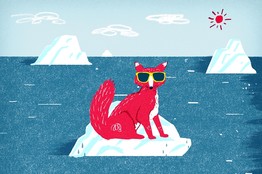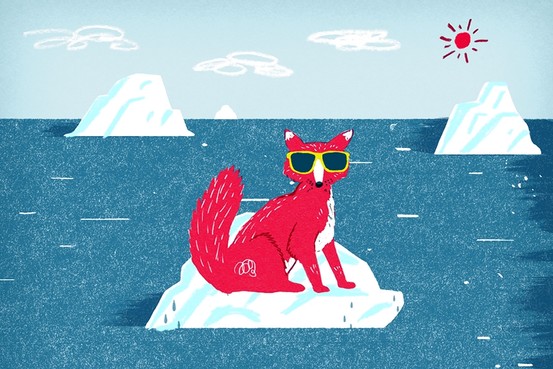What Arctic Foxes Know About Global Warming
This week probably saw the Arctic Ocean's sea ice reach its minimum extent for the year and begin to expand again, as it usually does in mid-September. Given that the retreat of Arctic ice has become a key piece of evidence for those who take a more alarmed view of global warming, it's newsworthy that 2012's melt was the greatest since records began in 1979, with sea ice in the Northern Hemisphere shrinking to about 1.3 million square miles, or about half the 1979-2008 average.
As this column has sometimes pointed out ways in which the effects of global warming are happening more slowly than predicted, it is fair to record that this rate of decline in Arctic sea ice is faster than many predicted. Although an entirely ice-free Arctic Ocean during at least one week a year is still several decades away at this rate, we are halfway there after just three decades.
Arctic melts on this scale have happened before, however. Svend Funder of the Danish Museum of Natural History and his colleagues recently studied the northern coast of Greenland, where the land-fast sea ice never breaks up, even in a year like this. Yet evidence of wave action in the past (indicating open waters) and waterlogged driftwood show that for 2,500 years in the "Holocene Optimum" period, when Arctic summer temperatures were two to four degrees Celsius warmer than today, the summer melt of the Arctic Ocean routinely left half as much ice as this year.
Another study, by Jørgen Berge and colleagues from the University Centre in Svalbard, Norway, and other institutions, discovered a downward migration of egg-carrying amphipod crustaceans that enables them to recolonize Arctic ice from ice-free areas using deep currents. They say this implies that some animals are well adapted to the seasonal loss of ice.
In the Holocene Optimum there was no collapse of the polar-bear population or "point of no return." The extent of Arctic summer sea ice then increased steadily, reaching a maximum during the very recent so-called Little Ice Age of 1500-1850. Potential confirmation that this was an unusually icy epoch comes from a newly published study by Durham University (in Britain) of the genetics of Arctic foxes on Iceland.
Greger Larson and his colleagues found that the remains of 17 Arctic foxes in Iceland from the ninth to the 12th centuries shared a single genetic signature, while the modern Icelandic fox population has five different genetic types. During the cold centuries, they infer, genetically diverse Arctic foxes from the Eurasian continent apparently reached Iceland via sea ice.
Anecdotal evidence suggests that the extent of summer Arctic sea ice then shrank after 1850, before expanding in the 1960s. Clearly, the Arctic Ocean's sea ice is both more variable and more vulnerable to warming than expected. But is the current rapid retreat caused only by warming? At least some of it might be caused by soot from dirty, coal-fired power stations. Some scientists have noticed that the decline in Arctic sea ice correlates better with the rapid growth of coal consumption in China than it does with global temperature. As the argument goes: Soot falling on white ice darkens it, which results in faster melting in summer sun.
Correlation does not always mean causation, but if soot is contributing to sea-ice melt, then it is moderately good news, because cleaning up soot emissions from power stations could be both cheaper and quicker than cutting carbon-dioxide emissions.
There's also the puzzling fact that Antarctic sea ice shows no sign of summer retreat, and the current winter's peak extent is well above average. The sea-dominated Southern Hemisphere is certainly warming more slowly than the land-dominated Northern Hemisphere, but it has still been warming. If warming is supposed to be "global," shouldn't sea ice retreat at both ends of the world?
Write to Matt Ridley at matt.ridley@dowjones.com
Copyright ©2012 Dow Jones & Company, Inc. All Rights Reserved.

